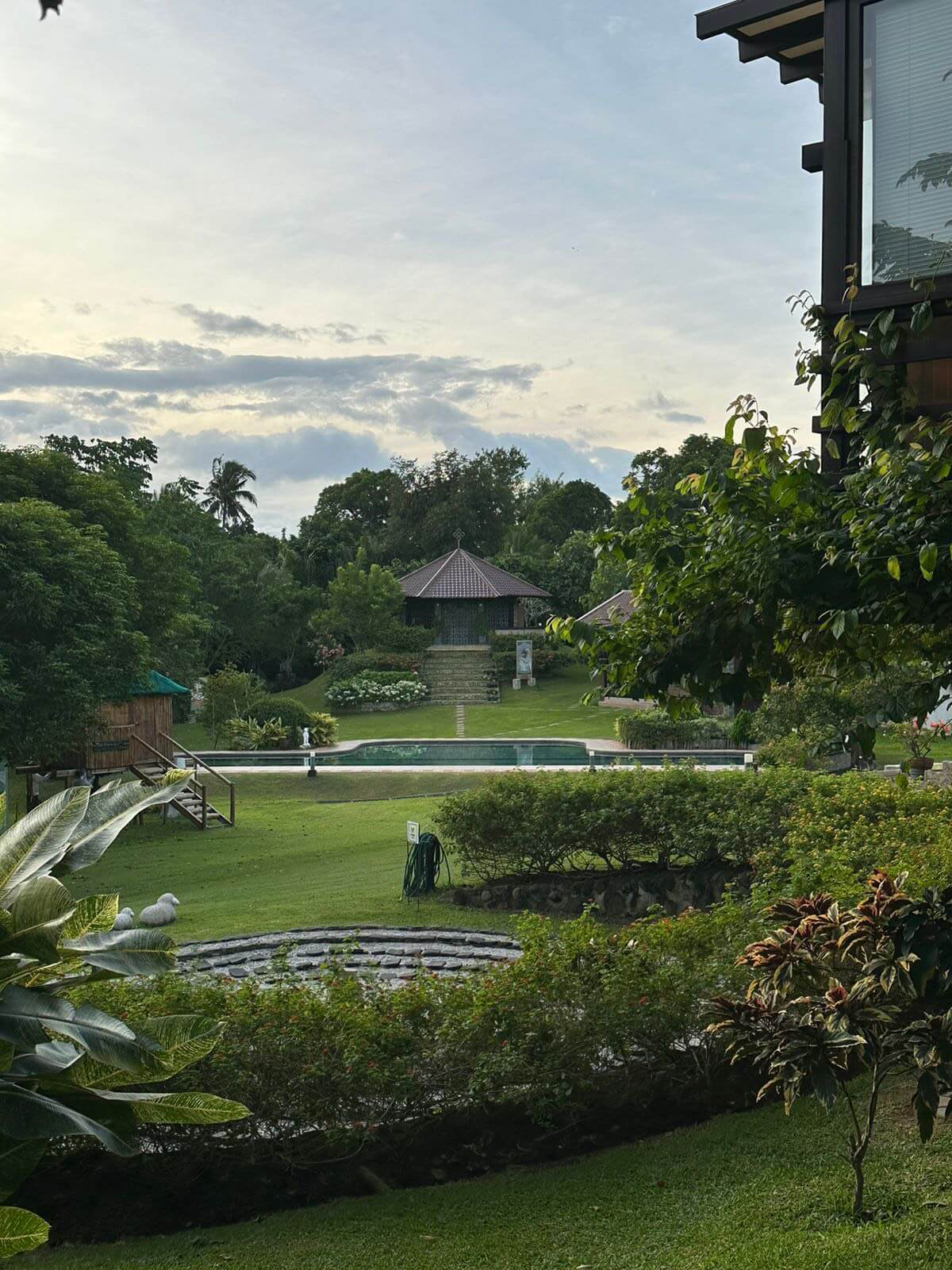
1. My Experience of Sacred Space
Around 2012, when I started deepening my interest and experience in soul companioning, I began to observe that there was something special about my house and garden. “Bethlehem” as I named it, is nestled in a beautiful location called “Highlands” in a city in the Philippines called Tagaytay with breathtaking views of the mountains. I realized that Bethlehem could be a place where people could encounter God. Indeed that became real as more and more people testified of such encounters after staying at my place. It did not require much effort from me or my other associates as we all engaged in accompanying them. Their very presence in the house surrounded by the gardens would naturally open them up to hear or sense God in their life.
I will not forget one exercise my spiritual director gave me during an 8 day silent retreat. She awoke an interest in me, in sacred spaces when she told me: “Go back to the place where you would regularly sit during your retreat and pray in and for that sacred space. Pray for the person who sat there before you, and ask God to bless his or her life. Then pray for the person who will be sitting there after you, and ask God to give them the graces that they ask for.” Her words were an epiphany to me; this was the first time I was conscious that spaces could be sacred.
Sacred spaces were key to my rhythm during my retreat:
• In the basement of the chapel while doing my morning prayers, I would sit on the same seat facing the direction of the electric fan set on no. 2, so I would feel cool.
• In the prayer room while gazing at a certain painting, I would rest on a chair with pillows set up in exactly the same position.
• Then after lunch under the trellis, I would find myself on the bench staring and intently listening to the soothing sound of the fountain with my pad and crayons.
• An afternoon nap would follow, where I would linger on the sofa in my bedroom afterwards.
• By around 4:00 pm when it was cooler, I would take a long, slow walk down a path for approximately thirty minutes ending in the same swing under the tree.
• My routine finished with holy mass at 6:00 pm. This ritual repeated for eight days straight. I had no clue why I chose this routine. I remember really liking the places where I would sit because it was there that I felt comfortable and at peace. Those were the places where I would hear God speak in meaningful ways. My director helped me realize that they were my “sacred spaces.”
2. The Nature Of Sacred Spaces
Sacred spaces throughout history
Throughout history, there has been an awareness of “sacred spaces” across many traditions and religions. In the ancient Taoist tradition of Feng Shui, there are certain areas where there is good energy, or qi, binding the universe, earth and humanity together. The ancient pagan Celts who lived in the British isles had similar beliefs. They noticed that in certain places “heaven and earth come closer” labelled by Eric Wiener, as “thin places” in his book Man Seeks God. This desire to memorialize and define these sacred places has occurred across cultures and religious backgrounds. Other examples include Upsala for the vikings, the oracle at Delphi and mount Olympus for the ancient Greeks, while similar places also exist for the Buddhists (Borobhudur), for the Hindus (Varanasi). Shinto shrines are invariably in forests. This concept of “thin spaces”, albeit not explicitly defined, is also acknowledged in monotheistic religions, such as Judiasm (Mount Sinai etc.), Christianity (Lourdes etc.), and Islam (Mecca & Medina). Nearly every religion and belief system is “situated” and either implicity or explicity acknowledges the importance of certain “sacred places” above others.
Sacred spaces are universal
However, sacred spaces are not dependent on one particular religion. In fact, often sacred spaces are universal. Jerusalem is a pilgrimage site for Judaism, Islam and Christianity. Countless Christian churches are built on the previous sites of existing pagan places of worship. Countless mosques and temples are built on previous Christian sites in many places in the world, Hagia Sofia mosque in Istanbul, being the most famous. Granted this might be due to political or economic factors, but places are often chosen for specific reasons in the beginning, precisely because they are considered to be “thin places”, i.e. they provide an interface between the incarnate and the divine.
The loss of sacred spaces
Unfortunately, as a result of the reformation and Enlightenment, “sacred spaces” have been considered the domain of “mystics” and are not widely considered in western forms of Christianity. Modern Christianity tends to struggle with Jesus’ incarnation, and prefers to view God as primarily spiritual and other-worldly. It treats spirit and matter as completely separate, like oil and water, whereas early Christianity held a more integrated worldview.
Sacred spaces are not just religious places
Not every sacred space is religious. A park or, a city square, an airport or even a bar can be a sacred space. Writing in his classic work “The Sacred and the Profane,” Mircea Eliade observed that “some parts of space are qualitatively different from others” yet they don’t need to be religious.
Garden
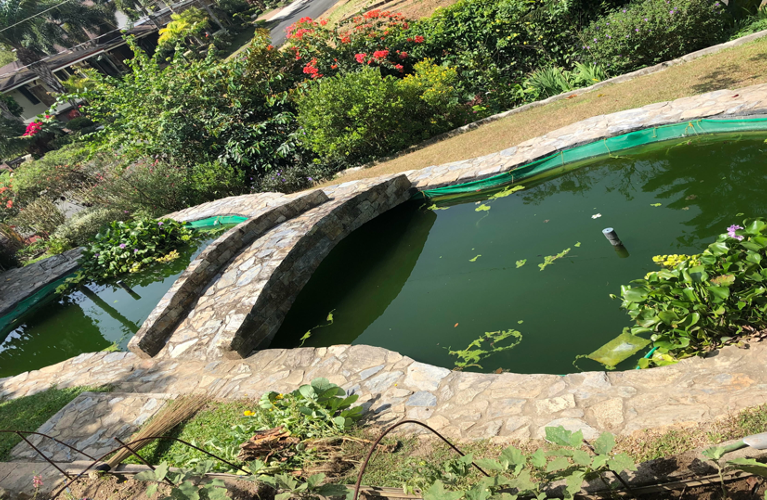
In the Buddhist tradition, gardens were particularly important as they were microcosms of the the larger cosmos. The use of water and manmade islets depict the separation between earth and heaven, with deities often placed on islands. Zen gardens are particularly focused on facilitating transcendence and meditation. The raking of the stones and pruning of the bonsai was encouraged as a form of active meditation.
In the Jewish and Christian traditions, I don’t think it is a coincidence for example that Adam and Even began in a garden, and that Jesus’ final hours were in a garden. We try to incorporate different traditions in our approach to landscaping sacred spaces.
Topography
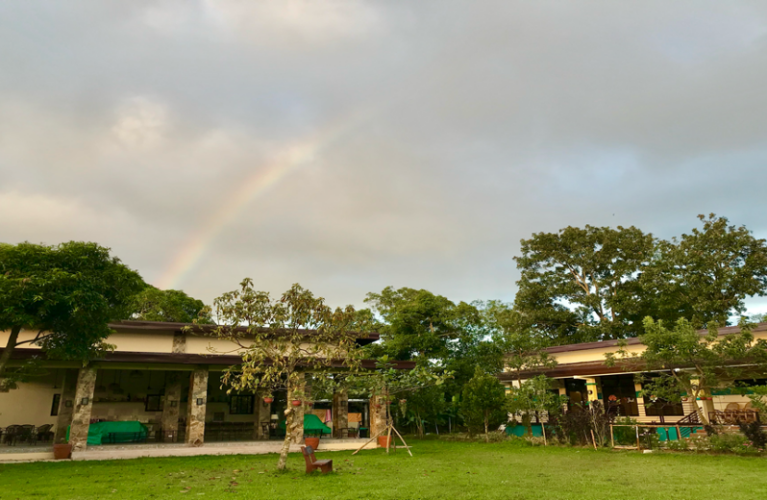
In creating places, we remember that people seeking God are also seeking refuge. For instance, it is preferable and in fact ideal to create places that are nestled on the hills as this gives a sense of security and comfort. We try to maximize the topography of our landscape to provide enclosed spaces of quiet and privacy but also vantage points for people to admire the landscape and God’s creation.
Boundaries
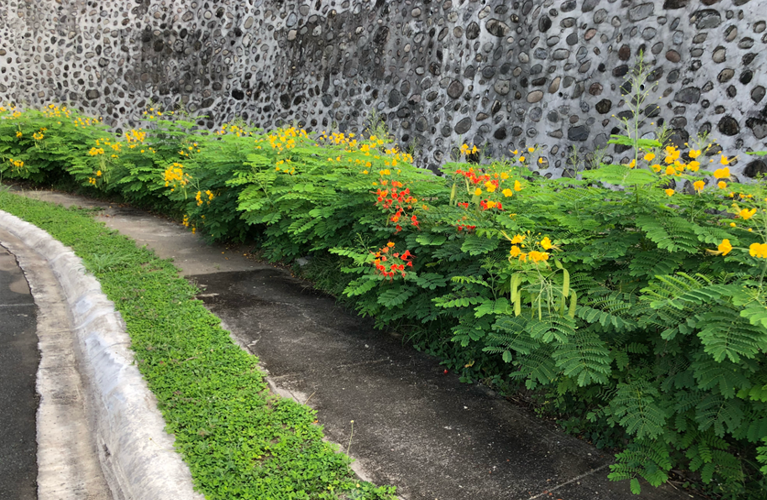
We build fences and boundaries using a variety of plants from bushes, to trees, to flowering plants, to plants that crawl. The use of vegetation to form boundaries is relaxing, whereas concrete walls and wire fences tend to feel harsh. Living walls give a sense of expansiveness, whilst also providing retreatants with a sense of protection and belonging. We use spirals, symmetry, and geometrical patterns to pull the eye towards a focal point.
Doors and Portals
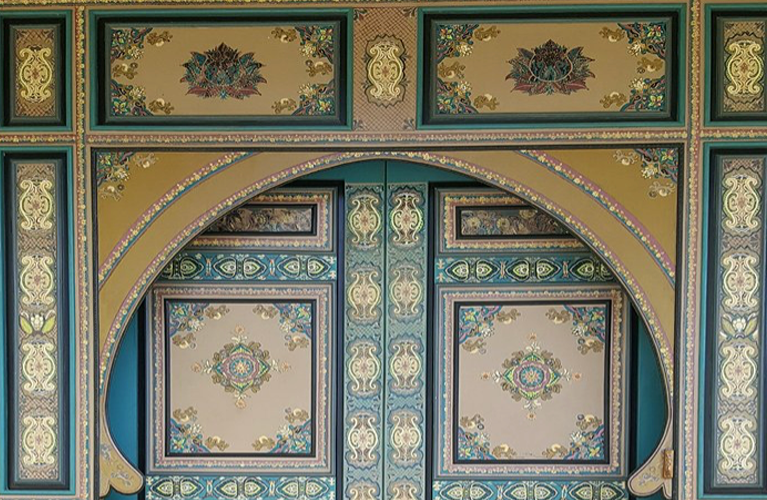
Doors and portals are symbols of transition. Something ends, while something else begins: death and rebirth. Most spiritual traditions are pregnant with images of transition. Doors and portals can be used to help people better reflect on these transitions.
Tunnels
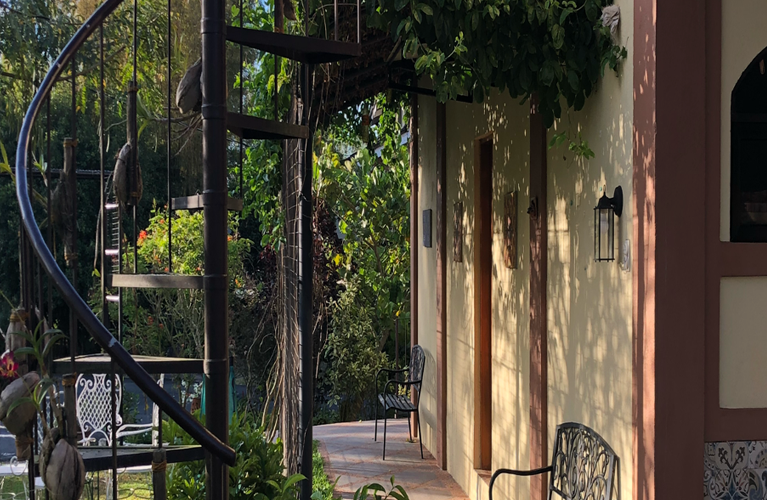
Tunnels made of trees: here in the Philippines it is common to use bamboo, and other tropical hardwood whose branches stretch out to meet other branches, creating natural tunnels, giving you a sense of being in a womb enclosed and secure. This form of landscaping is something we have been intentional about to give shade in most areas of the retreat center.
Pathways
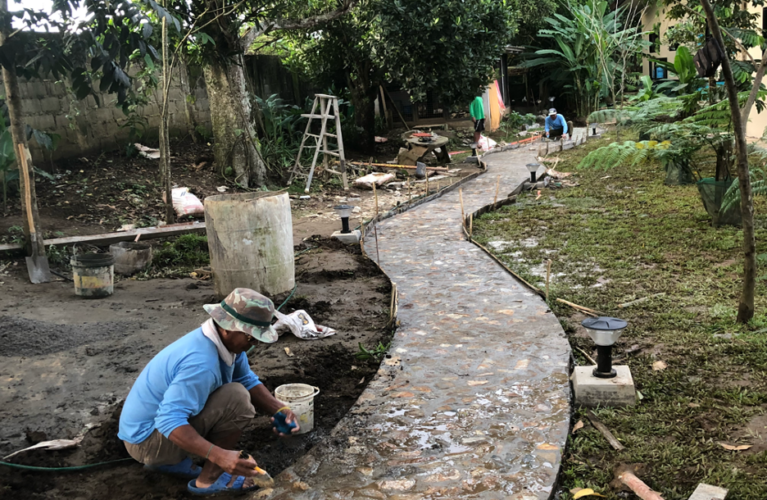
Whether pathways are winding or straight, they are symbolic of a journey or pilgrimage. The idea that our spiritual lives are metaphorical journeys permeates many world religions. Judiasm’s founding stories incorporate constant travel, often across deserts. Pilgrimages are also important components of Christianity and Islam. The choice of material when building pathways may give a sensation of bumpiness, smoothness, roughness, cohesiveness. The choices of materials all have symbolic and metaphorical implications and affect the impact of these sacred spaces.
A Destination
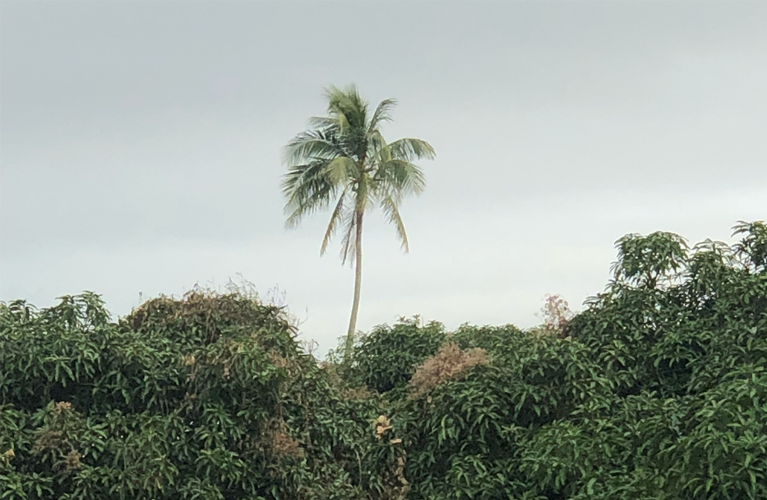
Art and sculptures are important as focal points. We are beginning to incorporate more sculptures and art, as retreatants find them helpful while they connect with the divine. It is no coincidence that art permeates nearly every place of worship in the world.
The symbolic and ineffable are man’s attempts to describe the un-seeable and unknowable; that which is beyond. Our aim is that the artwork encourages quiet, fascination, joy, and spiritual connection in harmony with nature.
Benches
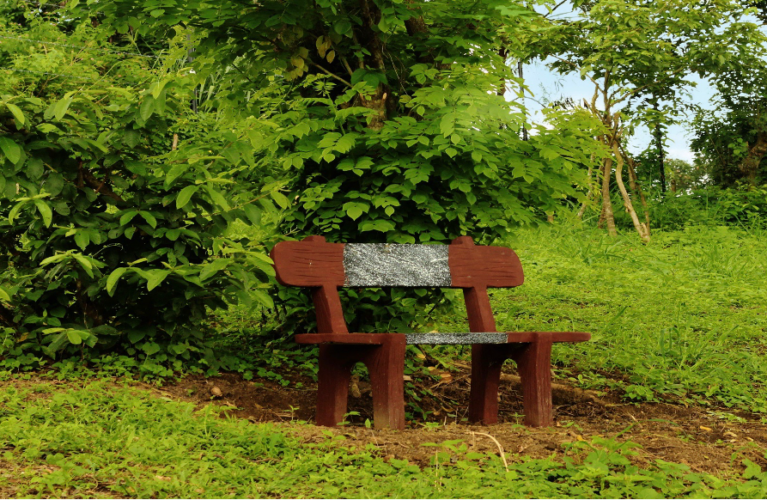
A place of respite that invites one to pause and reflect. to sit, to rest, to breathe, to be present, to oneself and to God. space on a hidden bench and converse with God. We have scattered benches randomly around the garden and the farm, in strategic places where shade can be found. We encourage retreatants to find their personal sacred
which is a anprofitfunds o:
Sacred spaces: universal but subjective
Of course, although many places are universally considered “sacred spaces”, there is also an element of subjectivity to identifying sacred spaces. Fritz Steele Author of “The Sense of Place” contends that human beings perceive places in a certain manner while 1 taking into account their own culture, temperament and status. He identified that there are “Place People.” They easily respond to stimuli and are sensitive to the spirit of the place.
They are open and aware and are able to see God in all things. These people are aware of the physical, spiritual as well as the social dimension of a place.
Why we seek out sacred spaces.
For generations have sought the field of acknowledges that can be found
Retreating to our sacred space
My pursuit of sacred spaces
Since my epiphany about the importance of sacred spaces in 2012, I have proactively searched out sacred spaces and places of natural beauty, quiet and solitude around the world, in order to deepen my experience of the divine and continue my inner journey to healing and wholeness. Through nature I have been refreshed, healed and restored.
My calling to share sacred spaces
As a result of the blessings I have received from this way of life, I have committed to taking care of nature so that others and the generations to come can experience the same therapeutic qualities that I have. In the last three years, I have built a 2.5 ha Eco- spirituality Retreat Center and organic farm, not far from my house, that provides a place for people to pray and to meet God. I have created my own collection of “thin spaces” on my farm, whether they are simple benches under ancient trees or our chapel to hold religious services.
3. Techniques for creating sacred spaces
As noted, not every sacred space is as grand as the Sistine chapel or Machu Picchu. Sacred spaces can be created in our own surroundings. There are certain techniques for creating places that invite reflection and contemplation of the divine. In Cherimoya farm, we have consciously tried to create sacred spaces using some of the methodologies presented below.
Nature
For what can be known about God is plain . . . because God has made it plain. . . . Ever since the creation of the world, God’s invisible nature, namely, God’s eternal power and deity, have been there for the mind to see in the things that God has made. —Romans 1:20
There is no better indication of the divine or a place beyond than nature itself. As such, all sacred spaces are fundamentally a celebration of God’s wonderful creation and as such we try to use as many natural elements as possible.
Sacred spaces choose us
Of course, the creation of sacred spaces has its limitations. Ultimately, we don’t choose places, but sacred spaces tend to choose us. We cannot manipulate the environment into a sacred space. We can only facilitate this process. According to spiritual author, Robert Hamma “the place is never chosen; it is merely discovered and these places 2 have a tendency to reveal themselves” to us.
When doing a retreat or just spending a protracted time with God, we may want to try different places where we can feel comfortable and at home and eventually, “the places reveal themselves to us.”
4. My Ministry Of Sacred Spaces
I have been very conscious and particular about how I design the various different spaces around my location. I believe there is a ministry of creating sacred spaces, which has become my main ministry since I built my 2 retreat centers. This was confirmed when I read and came across Open Spaces and Sacred Places . It seems that the people who had the vision to invest and design spaces and parks like this have a similar vision given to me by the Lord.
The works of art and the collection pieces have to blend together. I think about certain color combinations, making sure that every corner of the house and the garden has an inviting effect, gently drawing people into the area. In my country which is tropical in climate, I see to it that everything would be comfortable for the prayor and preferably cool enough so that the probable feeling of initial dis-ease is minimized.
Feedback and reviews
Indeed I have been given feedback by many of our retreatants that God felt really present to them in Bethlehem as they prayed and communed with God. One particularly encouraging comment made by someone who came to rest and refresh in the house was this: “Thank you for giving us this place where its name connotes Jesus in a manger, with the hospitality of a mansion.” Another said, “Entering here, it’s like I found this treasure hidden in a field. When I found it, I wanted to hide it, but because of my joy in this place, I want to tell the world about it.”
Still others have remarked this way: “This place is wonderful: the dome is full of light and air, it makes you feel the Holy Spirit is here.” And I also love this one: “This morning when I woke up and saw all the color, and heard the birds chirping, I felt like I went to bed last night and woke up and went to heaven.”
My Commitment:
I have committed myself to being the guardian of Bethlehem and Cherimoya Farm. I believe that part of my calling is to be the keeper and protector of the sacredness of my place, and keep out the profane. I have always felt a responsibility to protect the place. This begins with protecting my own life. This too, is a sacred life and I hold myself accountable God and others so that I can fulfill my calling to be the protector of this ministry and place. Even when it comes to choosing who we accept as part of our community of employees, it is important that they are called to hospitality too. We at Bethlehem know very well that surroundings are important, but equally as important is our humble service to the retreatant. Our welcome and, of course, our hospitality must reflect authenticity. Our genuine desire is to serve from the heart because as hospitable soul hosts, we assist in preparing the soul of the person to have a real encounter with God.